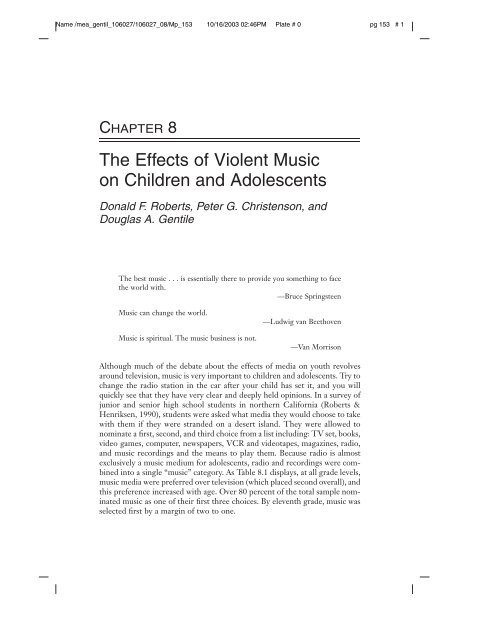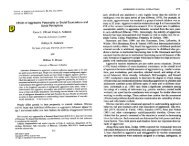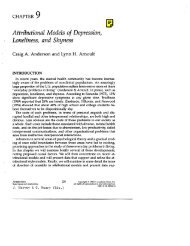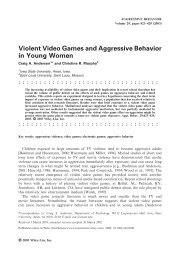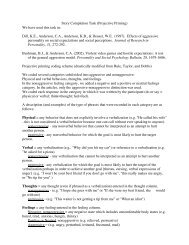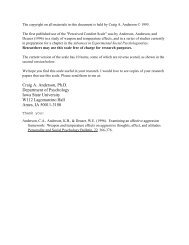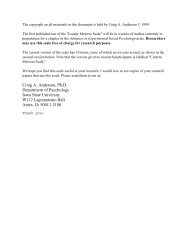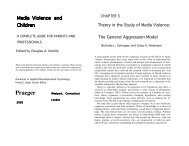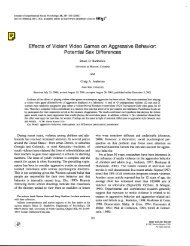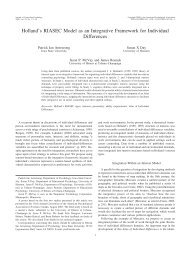The Effects of Violent Music on Children and Adolescents
The Effects of Violent Music on Children and Adolescents
The Effects of Violent Music on Children and Adolescents
Create successful ePaper yourself
Turn your PDF publications into a flip-book with our unique Google optimized e-Paper software.
Name /mea_gentil_106027/106027_08/Mp_153 10/16/2003 02:46PM Plate # 0 pg 153 # 1<br />
CHAPTER 8<br />
<str<strong>on</strong>g>The</str<strong>on</strong>g> <str<strong>on</strong>g>Effects</str<strong>on</strong>g> <str<strong>on</strong>g>of</str<strong>on</strong>g> <str<strong>on</strong>g>Violent</str<strong>on</strong>g> <str<strong>on</strong>g>Music</str<strong>on</strong>g><br />
<strong>on</strong> <strong>Children</strong> <strong>and</strong> <strong>Adolescents</strong><br />
D<strong>on</strong>ald F. Roberts, Peter G. Christens<strong>on</strong>, <strong>and</strong><br />
Douglas A. Gentile<br />
<str<strong>on</strong>g>The</str<strong>on</strong>g> best music . . . is essentially there to provide you something to face<br />
the world with.<br />
—Bruce Springsteen<br />
<str<strong>on</strong>g>Music</str<strong>on</strong>g> can change the world.<br />
<str<strong>on</strong>g>Music</str<strong>on</strong>g> is spiritual. <str<strong>on</strong>g>The</str<strong>on</strong>g> music business is not.<br />
—Ludwig van Beethoven<br />
—Van Morris<strong>on</strong><br />
Although much <str<strong>on</strong>g>of</str<strong>on</strong>g> the debate about the effects <str<strong>on</strong>g>of</str<strong>on</strong>g> media <strong>on</strong> youth revolves<br />
around televisi<strong>on</strong>, music is very important to children <strong>and</strong> adolescents. Try to<br />
change the radio stati<strong>on</strong> in the car after your child has set it, <strong>and</strong> you will<br />
quickly see that they have very clear <strong>and</strong> deeply held opini<strong>on</strong>s. In a survey <str<strong>on</strong>g>of</str<strong>on</strong>g><br />
junior <strong>and</strong> senior high school students in northern California (Roberts &<br />
Henriksen, 1990), students were asked what media they would choose to take<br />
with them if they were str<strong>and</strong>ed <strong>on</strong> a desert isl<strong>and</strong>. <str<strong>on</strong>g>The</str<strong>on</strong>g>y were allowed to<br />
nominate a first, sec<strong>on</strong>d, <strong>and</strong> third choice from a list including: TV set, books,<br />
video games, computer, newspapers, VCR <strong>and</strong> videotapes, magazines, radio,<br />
<strong>and</strong> music recordings <strong>and</strong> the means to play them. Because radio is almost<br />
exclusively a music medium for adolescents, radio <strong>and</strong> recordings were combined<br />
into a single “music” category. As Table 8.1 displays, at all grade levels,<br />
music media were preferred over televisi<strong>on</strong> (which placed sec<strong>on</strong>d overall), <strong>and</strong><br />
this preference increased with age. Over 80 percent <str<strong>on</strong>g>of</str<strong>on</strong>g> the total sample nominated<br />
music as <strong>on</strong>e <str<strong>on</strong>g>of</str<strong>on</strong>g> their first three choices. By eleventh grade, music was<br />
selected first by a margin <str<strong>on</strong>g>of</str<strong>on</strong>g> two to <strong>on</strong>e.
Name /mea_gentil_106027/106027_08/Mp_154 10/16/2003 02:46PM Plate # 0 pg 154 # 2<br />
154 Media Violence <strong>and</strong> <strong>Children</strong><br />
Table 8.1<br />
Which Medium Would <strong>Adolescents</strong> Take to a Desert Isle?<br />
Note: Figures are rounded to the nearest percentage<br />
Source: Adapted from Roberts, D. F., & Henriksen, L. (1990, June). <str<strong>on</strong>g>Music</str<strong>on</strong>g> listening vs.<br />
televisi<strong>on</strong> viewing am<strong>on</strong>g older adolescents. Paper presented at the annual meeting <str<strong>on</strong>g>of</str<strong>on</strong>g> the<br />
Internati<strong>on</strong>al Communicati<strong>on</strong> Associati<strong>on</strong>, Dublin, Irel<strong>and</strong>.<br />
<str<strong>on</strong>g>Music</str<strong>on</strong>g>’s importance to youth can also be measured by the amount <str<strong>on</strong>g>of</str<strong>on</strong>g> time<br />
they spend listening to it. One sample <str<strong>on</strong>g>of</str<strong>on</strong>g> Southeastern junior high school<br />
students spent an average <str<strong>on</strong>g>of</str<strong>on</strong>g> three hours per day listening to music <strong>and</strong> over<br />
four hours watching televisi<strong>on</strong> (Brown, Campbell, & Fischer, 1986). More<br />
recent studies have shown similar high numbers for music. In a study <str<strong>on</strong>g>of</str<strong>on</strong>g> over<br />
600 eighth <strong>and</strong> ninth graders from public <strong>and</strong> private schools in Minnesota<br />
(Gentile, Lynch, Linder, & Walsh, in press), children reported spending an<br />
average <str<strong>on</strong>g>of</str<strong>on</strong>g> almost 21 hours per week listening to music, compared to 25 hours<br />
per week watching televisi<strong>on</strong> (Table 8.2). This pattern can also be seen across<br />
larger age ranges, although the amount <str<strong>on</strong>g>of</str<strong>on</strong>g> time spent with music increases<br />
with age (e.g., Roberts, Foehr, Rideout, & Brodie, 1999). However, it is likely<br />
that most studies underestimate the amount <str<strong>on</strong>g>of</str<strong>on</strong>g> time children <strong>and</strong> adolescents<br />
may listen to music, because music is so <str<strong>on</strong>g>of</str<strong>on</strong>g>ten a sec<strong>on</strong>dary background activity<br />
for many other activities, such as reading, studying, talking, driving, <strong>and</strong> doing<br />
housework. <str<strong>on</strong>g>Music</str<strong>on</strong>g>’s tendency to slip between foreground <strong>and</strong> background<br />
raises questi<strong>on</strong>s about what kind <str<strong>on</strong>g>of</str<strong>on</strong>g> “listening” should be counted as true<br />
exposure. We believe background listening ought to be included, <strong>and</strong> for those<br />
who might disagree we <str<strong>on</strong>g>of</str<strong>on</strong>g>fer this challenge: Simply turn <str<strong>on</strong>g>of</str<strong>on</strong>g>f the “background”<br />
music when youth are studying, chatting, or doing chores <strong>and</strong> observe their<br />
resp<strong>on</strong>ses.<br />
Research that addresses all listening, whether from radio or other sources<br />
<strong>and</strong> whether background or foreground, finds levels <str<strong>on</strong>g>of</str<strong>on</strong>g> exposure to music at<br />
least as high as to TV in late grade school <strong>and</strong> c<strong>on</strong>siderably higher in adolescence.<br />
For example, <strong>on</strong>e survey required sixth <strong>and</strong> tenth graders to report how<br />
much time they had spent the previous day watching televisi<strong>on</strong>, listening to
Name /mea_gentil_106027/106027_08/Mp_155 10/16/2003 02:46PM Plate # 0 pg 155 # 3<br />
<str<strong>on</strong>g>The</str<strong>on</strong>g> <str<strong>on</strong>g>Effects</str<strong>on</strong>g> <str<strong>on</strong>g>of</str<strong>on</strong>g> <str<strong>on</strong>g>Violent</str<strong>on</strong>g> <str<strong>on</strong>g>Music</str<strong>on</strong>g> <strong>on</strong> <strong>Children</strong> <strong>and</strong> <strong>Adolescents</strong> 155<br />
Table 8.2<br />
Average Amounts <str<strong>on</strong>g>of</str<strong>on</strong>g> Media Use by Eighth <strong>and</strong> Ninth Grade Students (Hours/<br />
Week)<br />
Note: M mean, SD st<strong>and</strong>ard deviati<strong>on</strong><br />
a<br />
Means significantly different from each other at p 0.05.<br />
b<br />
Means significantly different from each other at p 0.01.<br />
c<br />
Means significantly different from each other at p 0.001.<br />
Source: Adapted from Gentile, D. A., Lynch, P. J., Linder, J. R., & Walsh, D. A. (in<br />
press). <str<strong>on</strong>g>The</str<strong>on</strong>g> effects <str<strong>on</strong>g>of</str<strong>on</strong>g> violent video game habits <strong>on</strong> adolescent hostility, aggressive<br />
behaviors, <strong>and</strong> school performance. Journal <str<strong>on</strong>g>of</str<strong>on</strong>g> Adolescence.<br />
the radio, <strong>and</strong> listening to audio recordings (Greenberg, Ku, & Li, 1989).<br />
Sixth graders reported 4.1 hours <str<strong>on</strong>g>of</str<strong>on</strong>g> TV viewing <strong>and</strong> 3.8 hours <str<strong>on</strong>g>of</str<strong>on</strong>g> combined<br />
music listening; tenth graders reported 3.9 hours <str<strong>on</strong>g>of</str<strong>on</strong>g> TV viewing compared to<br />
4.9 hours <str<strong>on</strong>g>of</str<strong>on</strong>g> music listening.<br />
Amount <str<strong>on</strong>g>of</str<strong>on</strong>g> listening is not uniform across all groups <str<strong>on</strong>g>of</str<strong>on</strong>g> youth. First, age<br />
makes a big difference: adolescents devote more time to music than schoolage<br />
children, <strong>and</strong> older adolescents devote more time to music than younger<br />
adolescents. Although many children begin listening to popular music early<br />
in the grade-school years (Christens<strong>on</strong>, DeBenedittis, & Lindl<str<strong>on</strong>g>of</str<strong>on</strong>g>, 1985), televisi<strong>on</strong><br />
c<strong>on</strong>sumes a much greater amount <str<strong>on</strong>g>of</str<strong>on</strong>g> time for younger children than<br />
does music. About the beginning <str<strong>on</strong>g>of</str<strong>on</strong>g> junior high school, however, this pattern<br />
begins to change. <str<strong>on</strong>g>The</str<strong>on</strong>g> early teen years mark a sharp increase in the amount<br />
<str<strong>on</strong>g>of</str<strong>on</strong>g> time kids devote to popular music, <strong>and</strong> the trend toward higher levels <str<strong>on</strong>g>of</str<strong>on</strong>g><br />
music c<strong>on</strong>sumpti<strong>on</strong> c<strong>on</strong>tinues through the end <str<strong>on</strong>g>of</str<strong>on</strong>g> high school.<br />
Girls also tend to listen more than boys, at least <strong>on</strong>ce adolescence is<br />
reached. Although research <strong>on</strong> grade schoolers finds no significant sexcorrelated<br />
differences in amount <str<strong>on</strong>g>of</str<strong>on</strong>g> listening (Christens<strong>on</strong> & DeBenedittis,<br />
1986; Lyle & H<str<strong>on</strong>g>of</str<strong>on</strong>g>fman, 1972), this picture begins to change about the time<br />
children enter middle school. By high school, girls listen substantially more<br />
than boys do (Greenberg et al., 1989; Roberts & Foehr, in press; Roberts &<br />
Henriksen, 1990), <strong>and</strong> African American youth tend to listen more than whites<br />
(Brown, Childers, Bauman, & Koch, 1990).
Name /mea_gentil_106027/106027_08/Mp_156 10/16/2003 02:46PM Plate # 0 pg 156 # 4<br />
156 Media Violence <strong>and</strong> <strong>Children</strong><br />
USES AND GRATIFICATIONS OF POPULAR MUSIC<br />
At the simplest, most global level, people <str<strong>on</strong>g>of</str<strong>on</strong>g> all ages listen to music because<br />
it provides pleasure. For adolescents especially, the pleasure can be intense<br />
<strong>and</strong> tends to be associated with the most intense, “peak” experiences <str<strong>on</strong>g>of</str<strong>on</strong>g> life.<br />
Lull (1992, p. 1) has stated, “<str<strong>on</strong>g>Music</str<strong>on</strong>g> promotes experiences <str<strong>on</strong>g>of</str<strong>on</strong>g> the extreme for<br />
its makers <strong>and</strong> listeners, turning the perilous emoti<strong>on</strong>al edges, vulnerabilities,<br />
triumphs, celebrati<strong>on</strong>s, <strong>and</strong> antag<strong>on</strong>isms <str<strong>on</strong>g>of</str<strong>on</strong>g> life into hypnotic, reflective tempos<br />
that can be experienced privately or shared with others.” Given the importance<br />
<str<strong>on</strong>g>of</str<strong>on</strong>g> music <strong>and</strong> its central role in adolescence, it is clear that it has a<br />
number <str<strong>on</strong>g>of</str<strong>on</strong>g> important effects. Yet although there has been c<strong>on</strong>cern for decades<br />
about possible deleterious effects <str<strong>on</strong>g>of</str<strong>on</strong>g> popular music, for most children, the<br />
effects are not deleterious. While this chapter cannot describe in detail the<br />
uses <str<strong>on</strong>g>of</str<strong>on</strong>g> music, we will describe briefly three major uses: affective uses, social<br />
uses, <strong>and</strong> the uses <str<strong>on</strong>g>of</str<strong>on</strong>g> lyrics (for a detailed review, see Christens<strong>on</strong> & Roberts,<br />
1998). It also should be noted that the research <strong>on</strong> music videos appears to<br />
show different effects from music al<strong>on</strong>e; thus music videos will be discussed<br />
later in this chapter.<br />
Affective Uses<br />
<str<strong>on</strong>g>The</str<strong>on</strong>g> major difference between popular music <strong>and</strong> other media lies in music’s<br />
ability to enhance or modify mood. In a study <str<strong>on</strong>g>of</str<strong>on</strong>g> Swedish adolescents, Roe<br />
(1985) presented possible reas<strong>on</strong>s for listening to music <strong>and</strong> asked students to<br />
indicate how <str<strong>on</strong>g>of</str<strong>on</strong>g>ten each applied to their listening. Factor analyses revealed<br />
three general trends: (1) atmosphere creati<strong>on</strong> <strong>and</strong> mood c<strong>on</strong>trol, (2) silencefilling<br />
<strong>and</strong> passing the time, <strong>and</strong> (3) attenti<strong>on</strong> to lyrics. Of the three types <str<strong>on</strong>g>of</str<strong>on</strong>g><br />
uses, atmosphere creati<strong>on</strong> <strong>and</strong> mood c<strong>on</strong>trol emerged as the most important,<br />
with time-filling sec<strong>on</strong>d <strong>and</strong> attenti<strong>on</strong> to lyrics a distant third. Summarizing<br />
the research <strong>on</strong> adolescent uses <str<strong>on</strong>g>of</str<strong>on</strong>g> music, Christens<strong>on</strong> & Roberts (1998, p. 48)<br />
suggested a principle they labeled “the primacy <str<strong>on</strong>g>of</str<strong>on</strong>g> affect.” For most young<br />
people, music use is driven primarily by the motivati<strong>on</strong> to c<strong>on</strong>trol mood <strong>and</strong><br />
enhance emoti<strong>on</strong>al states. <str<strong>on</strong>g>Music</str<strong>on</strong>g>’s ability to communicate emoti<strong>on</strong> <strong>and</strong> influence<br />
mood has been widely noted. Even preschoolers <strong>and</strong> infants as young as<br />
eight m<strong>on</strong>ths can reliably discriminate “happy” <strong>and</strong> “sad” music (Gentile &<br />
Pick, under review; Gentile, Pick, Flom, & Campos, 1994; Gentile, Stoerzinger,<br />
Finney, & Pick, 1996; Sullivan, Gentile, & Pick, 1998). Studies <str<strong>on</strong>g>of</str<strong>on</strong>g> mood<br />
inducti<strong>on</strong> <str<strong>on</strong>g>of</str<strong>on</strong>g>ten use music in order to change people’s moods (e.g., Kenealy,<br />
1988; Pignatiello, Camp, Elder, & Rasar, 1989; Pignatiello, Camp, & Rasar,<br />
1986). Because <str<strong>on</strong>g>of</str<strong>on</strong>g> the affective efficacy <str<strong>on</strong>g>of</str<strong>on</strong>g> music, when adolescents want to be<br />
in a certain mood, when they seek reinforcement for a certain mood, when<br />
they feel l<strong>on</strong>ely, or when they seek distracti<strong>on</strong> from their troubles, music tends<br />
to be the medium <str<strong>on</strong>g>of</str<strong>on</strong>g> choice to accomplish the task.<br />
While both males <strong>and</strong> females report using music to affirm or manage their
Name /mea_gentil_106027/106027_08/Mp_157 10/16/2003 02:46PM Plate # 0 pg 157 # 5<br />
<str<strong>on</strong>g>The</str<strong>on</strong>g> <str<strong>on</strong>g>Effects</str<strong>on</strong>g> <str<strong>on</strong>g>of</str<strong>on</strong>g> <str<strong>on</strong>g>Violent</str<strong>on</strong>g> <str<strong>on</strong>g>Music</str<strong>on</strong>g> <strong>on</strong> <strong>Children</strong> <strong>and</strong> <strong>Adolescents</strong> 157<br />
moods, there are some c<strong>on</strong>sistent differences in their goals. Research shows<br />
that males are more likely than females to use music as a tool to increase their<br />
energy level <strong>and</strong> seek stimulati<strong>on</strong>—that is, to get “pumped up.” In c<strong>on</strong>trast,<br />
females are more likely than males to listen to lift their spirits when they’re<br />
sad or l<strong>on</strong>ely, or even to dwell <strong>on</strong> a somber mood (Arnett, 1991a; Lars<strong>on</strong>,<br />
Kubey, & Colletti, 1989; Roe, 1985; Wells, 1990). Although they do so less<br />
comm<strong>on</strong>ly than females, males will also match music with their negative<br />
moods. In the same way that girls <str<strong>on</strong>g>of</str<strong>on</strong>g>ten listen to sad s<strong>on</strong>gs when they are sad,<br />
many heavy metal fans say they listen to angry music when they are angry. In<br />
<strong>on</strong>e study, a typical heavy metal fan said he sought out “full-blown thrashing<br />
metal” when he was “mad at the world” (Arnett, 1991a, p. 82).<br />
Social Uses<br />
Some have suggested that while the emoti<strong>on</strong>al uses <str<strong>on</strong>g>of</str<strong>on</strong>g> popular music are<br />
important, the social uses <strong>and</strong> meanings provide the real key to underst<strong>and</strong>ing<br />
its niche in the lives <str<strong>on</strong>g>of</str<strong>on</strong>g> youth (Frith, 1981; Lull, 1987; Roe, 1984, 1985). For<br />
this discussi<strong>on</strong>, we suggest two divisi<strong>on</strong>s within the broad category <str<strong>on</strong>g>of</str<strong>on</strong>g> social<br />
uses: “quasi-social” uses <strong>and</strong> “socializing” uses. By quasi-social, we mean listening<br />
that occurs al<strong>on</strong>e but still serves goals <strong>and</strong> needs related to social relati<strong>on</strong>ships.<br />
Perhaps the best example <str<strong>on</strong>g>of</str<strong>on</strong>g> this is when music replaces or invokes the presence<br />
<str<strong>on</strong>g>of</str<strong>on</strong>g> absent peers in order to relieve feelings <str<strong>on</strong>g>of</str<strong>on</strong>g> l<strong>on</strong>eliness. For example, in<br />
a study <str<strong>on</strong>g>of</str<strong>on</strong>g> college students, two-thirds reported listening either “somewhat<br />
frequently” or “very frequently” to “make me feel less al<strong>on</strong>e when I’m by<br />
myself” (Gantz, Gartenberg, Pears<strong>on</strong>, & Schiller, 1978). This <strong>and</strong> other studies<br />
suggest that this quasi-social use is more comm<strong>on</strong> for girls than for boys<br />
(Lars<strong>on</strong> et al., 1989; Roe, 1984). Solitary music listening may also perform a<br />
number <str<strong>on</strong>g>of</str<strong>on</strong>g> “delayed” social uses (Lull, 1987), by preparing youth for future<br />
peer interacti<strong>on</strong>s <strong>and</strong> relati<strong>on</strong>ships. <str<strong>on</strong>g>The</str<strong>on</strong>g>re is a str<strong>on</strong>g c<strong>on</strong>necti<strong>on</strong> between<br />
interest in popular music <strong>and</strong> peer orientati<strong>on</strong>. To a large extent, those who<br />
know nothing about pop culture or current music trends are relegated to the<br />
periphery <str<strong>on</strong>g>of</str<strong>on</strong>g> youth culture. C<strong>on</strong>versely, adolescent pop music “experts” tend<br />
to have more friends <strong>and</strong> enjoy enhanced status in the adolescent social structure<br />
(Ad<strong>on</strong>i, 1978; Brown & O’Leary, 1971; Dominick, 1974).<br />
By socializing uses, we mean two broad types <str<strong>on</strong>g>of</str<strong>on</strong>g> uses: (1) those that occur<br />
within the c<strong>on</strong>text <str<strong>on</strong>g>of</str<strong>on</strong>g> a social occasi<strong>on</strong>, <strong>and</strong> (2) those that help to define social<br />
boundaries (Christens<strong>on</strong> & Roberts, 1998). Social occasi<strong>on</strong>s may take various<br />
forms (Lull, 1987). In romantic dyads, music is used to accompany courtship<br />
<strong>and</strong> sexual behavior. In friendships, music <str<strong>on</strong>g>of</str<strong>on</strong>g>ten provides a basis for the initial<br />
b<strong>on</strong>d, <strong>and</strong> <str<strong>on</strong>g>of</str<strong>on</strong>g>ten helps to maintain the relati<strong>on</strong>ship. In larger gatherings, such<br />
as parties, dances, or clubs, music reduces inhibiti<strong>on</strong>s, attracts attenti<strong>on</strong> <strong>and</strong><br />
approval, provides topics for c<strong>on</strong>versati<strong>on</strong>, <strong>and</strong> encourages dancing.<br />
<str<strong>on</strong>g>Music</str<strong>on</strong>g> also works at a more diffuse social level to define the important<br />
subgroups in adolescent culture <strong>and</strong> to identify who bel<strong>on</strong>gs to them. Al-
Name /mea_gentil_106027/106027_08/Mp_158 10/16/2003 02:46PM Plate # 0 pg 158 # 6<br />
158 Media Violence <strong>and</strong> <strong>Children</strong><br />
though it is far from the <strong>on</strong>ly cue about group membership—school performance,<br />
extracurricular interests, social background, clothing, <strong>and</strong> other<br />
elements <str<strong>on</strong>g>of</str<strong>on</strong>g> pers<strong>on</strong>al style figure in too—an adolescent’s music affiliati<strong>on</strong> says<br />
much about his or her social affiliati<strong>on</strong>. Popular music at <strong>on</strong>ce expresses,<br />
creates, <strong>and</strong> perpetuates the essential “us-them” distincti<strong>on</strong>s that develop between<br />
groups. <str<strong>on</strong>g>The</str<strong>on</strong>g> most typically discussed us-them distincti<strong>on</strong> is between<br />
youth <strong>and</strong> adults, although this is not likely to be the most important <strong>on</strong>e.<br />
For many youth, the type <str<strong>on</strong>g>of</str<strong>on</strong>g> music <strong>on</strong>e listens to helps to define <strong>on</strong>eself <strong>and</strong><br />
<strong>on</strong>e’s in-group. <str<strong>on</strong>g>Music</str<strong>on</strong>g> style, defined as the selecti<strong>on</strong> <str<strong>on</strong>g>of</str<strong>on</strong>g> a certain type <str<strong>on</strong>g>of</str<strong>on</strong>g> music<br />
<strong>and</strong> a pers<strong>on</strong>al style to go with it, is <strong>on</strong>e <str<strong>on</strong>g>of</str<strong>on</strong>g> the most powerful identifying<br />
markers in the school crowd structure. Within any high school it is usually<br />
easy to classify many subgroups <str<strong>on</strong>g>of</str<strong>on</strong>g> adolescents according to their music preferences<br />
(e.g., “metalheads,” “goths,” “alternatives,” “hip-hop,” “punkers,”<br />
“rastas,” etc.). <str<strong>on</strong>g>The</str<strong>on</strong>g>se labels may change as music changes, but the underlying<br />
processes <str<strong>on</strong>g>of</str<strong>on</strong>g> adolescent subcultures are likely to remain the same.<br />
<str<strong>on</strong>g>The</str<strong>on</strong>g> social uses <str<strong>on</strong>g>of</str<strong>on</strong>g> music make a great deal <str<strong>on</strong>g>of</str<strong>on</strong>g> sense when c<strong>on</strong>sidered with<br />
reference to the developmental tasks at different ages (for details see Gentile<br />
& Sesma, chapter 2, this volume). In middle childhood, especially after age<br />
eight, children begin to become more interested in popular music. As we have<br />
seen, this interest increases through adolescence. Two <str<strong>on</strong>g>of</str<strong>on</strong>g> the key developmental<br />
tasks <str<strong>on</strong>g>of</str<strong>on</strong>g> middle childhood are (1) to learn how to be accepted by peers<br />
<strong>and</strong> to build loyal friendships, <strong>and</strong> (2) to c<strong>on</strong>solidate the self-c<strong>on</strong>cept (especially<br />
in terms <str<strong>on</strong>g>of</str<strong>on</strong>g> “which group do I bel<strong>on</strong>g to?”). Popular music serves these<br />
goals very well. As has been menti<strong>on</strong>ed, popular music <str<strong>on</strong>g>of</str<strong>on</strong>g>ten can serve as the<br />
initial basis for friendships, <strong>and</strong> is important for peer acceptance (e.g., Ad<strong>on</strong>i,<br />
1978; Brown & O’Leary, 1971). In adolescence, two key developmental tasks<br />
are (1) to learn to build intimate relati<strong>on</strong>ships (both same-sex <strong>and</strong> cross-sex),<br />
<strong>and</strong> (2) to develop a pers<strong>on</strong>al identity (in terms <str<strong>on</strong>g>of</str<strong>on</strong>g> “how am I different from<br />
others?”). Popular music c<strong>on</strong>tinues to serve these goals well, by becoming<br />
part <str<strong>on</strong>g>of</str<strong>on</strong>g> the social backdrop for exploring feelings <str<strong>on</strong>g>of</str<strong>on</strong>g> intimacy <strong>and</strong> by defining<br />
in-groups <strong>and</strong> out-groups al<strong>on</strong>g lines <str<strong>on</strong>g>of</str<strong>on</strong>g> musical preferences.<br />
<str<strong>on</strong>g>The</str<strong>on</strong>g> Uses <str<strong>on</strong>g>of</str<strong>on</strong>g> <str<strong>on</strong>g>Music</str<strong>on</strong>g> Lyrics<br />
When asked why they like to listen to music, youth rarely list the lyrics as<br />
the main reas<strong>on</strong>. Usually it is something about the “sound” <str<strong>on</strong>g>of</str<strong>on</strong>g> the music that<br />
attracts them. However, lyrics are far from irrelevant—they are menti<strong>on</strong>ed as<br />
a primary gratificati<strong>on</strong> by a significant number <str<strong>on</strong>g>of</str<strong>on</strong>g> youth <strong>and</strong> a sec<strong>on</strong>dary gratificati<strong>on</strong><br />
by most (Gantz et al., 1978; Roe, 1985). In <strong>on</strong>e study (Rouner, 1990),<br />
high school students were asked to rank music against several other possible<br />
sources <str<strong>on</strong>g>of</str<strong>on</strong>g> moral <strong>and</strong> social guidance, including parents, teachers, friends,<br />
church leaders, <strong>and</strong> coworkers. Sixteen percent ranked music am<strong>on</strong>g the top<br />
three sources <str<strong>on</strong>g>of</str<strong>on</strong>g> moral guidance, <strong>and</strong> 24 percent placed music in the top three
Name /mea_gentil_106027/106027_08/Mp_159 10/16/2003 02:46PM Plate # 0 pg 159 # 7<br />
<str<strong>on</strong>g>The</str<strong>on</strong>g> <str<strong>on</strong>g>Effects</str<strong>on</strong>g> <str<strong>on</strong>g>of</str<strong>on</strong>g> <str<strong>on</strong>g>Violent</str<strong>on</strong>g> <str<strong>on</strong>g>Music</str<strong>on</strong>g> <strong>on</strong> <strong>Children</strong> <strong>and</strong> <strong>Adolescents</strong> 159<br />
for informati<strong>on</strong> <strong>on</strong> social interacti<strong>on</strong>. For better or worse, then, lyrics are<br />
<str<strong>on</strong>g>of</str<strong>on</strong>g>ten attended to, processed, discussed, memorized, <strong>and</strong> even taken to heart.<br />
Given the c<strong>on</strong>troversy surrounding antisocial themes that are sometimes<br />
present in heavy metal <strong>and</strong> rap lyrics, it is important to note that heavy metal<br />
<strong>and</strong> rap fans report much higher levels <str<strong>on</strong>g>of</str<strong>on</strong>g> interest <strong>and</strong> attenti<strong>on</strong> to lyrics than<br />
do teens in general (Arnett, 1991a; Kuwahara, 1992). Two general patterns<br />
seem to emerge from the research <strong>on</strong> attenti<strong>on</strong> to lyrics: First, the more<br />
important music is to an adolescent, the more importance he or she places <strong>on</strong><br />
lyrics relative to other elements <str<strong>on</strong>g>of</str<strong>on</strong>g> music gratificati<strong>on</strong>. Sec<strong>on</strong>d, attenti<strong>on</strong> to<br />
lyrics is highest am<strong>on</strong>g fans <str<strong>on</strong>g>of</str<strong>on</strong>g> oppositi<strong>on</strong>al or c<strong>on</strong>troversial music (whether it<br />
be 1960s protest folk or rock or the heavy metal <strong>and</strong> rap <str<strong>on</strong>g>of</str<strong>on</strong>g> today). In other<br />
words, the more defiant, alienated, <strong>and</strong> threatening to the mainstream a music<br />
type is, the more closely its fans follow the words (Christens<strong>on</strong> & Roberts,<br />
1998).<br />
THE EFFECTS OF VIOLENT MUSIC ON YOUTH<br />
Most <str<strong>on</strong>g>of</str<strong>on</strong>g> the criticism aimed at current popular music stems from the assumpti<strong>on</strong><br />
that “c<strong>on</strong>tent” (i.e., the attitudes, values, <strong>and</strong> behaviors portrayed<br />
in lyrics) may influence how young listeners think <strong>and</strong> act. Not surprisingly,<br />
it is a c<strong>on</strong>cern that emphasizes the negatives, such as violence, misogyny,<br />
racism, suicide, Satanism, <strong>and</strong> substance abuse (Carey, 1969; Christens<strong>on</strong> &<br />
Roberts, 1998; Fedler, Hall, & Tanzi, 1982; Roberts, Henriksen, & Christens<strong>on</strong>,<br />
1999). Articles have even been written with headlines like “Hard rock<br />
music creates killer mice!” based <strong>on</strong> high school science-fair experiments in<br />
which groups <str<strong>on</strong>g>of</str<strong>on</strong>g> mice were trained to run mazes. Groups <str<strong>on</strong>g>of</str<strong>on</strong>g> mice listened to<br />
classical music, hard rock, or no music. <str<strong>on</strong>g>The</str<strong>on</strong>g> classical mice became faster in<br />
running the maze, whereas the hard rock mice became slower. <str<strong>on</strong>g>The</str<strong>on</strong>g> student<br />
performing the study stated, “I had to cut my project short because all the<br />
hard-rock mice killed each other. . . . N<strong>on</strong>e <str<strong>on</strong>g>of</str<strong>on</strong>g> the classical mice did that”<br />
(Eat<strong>on</strong>, 1997; Health, Wealth, & Happiness, n.d.).<br />
Regardless <str<strong>on</strong>g>of</str<strong>on</strong>g> the merits <str<strong>on</strong>g>of</str<strong>on</strong>g> such alarmist reports, it is difficult to deny that<br />
music has become more aggressive <strong>and</strong> edgy over the decades. In 1958, the<br />
Everly Brothers sang, “When I want you in my arms, all I have to do is<br />
dream.” Twenty-eight years later, the message had been simplified to, “Hey,<br />
we want some pussy” (2 Live Crew, 1986). Claims that popular s<strong>on</strong>g lyrics<br />
pose a danger implicitly assume that young people interpret s<strong>on</strong>gs in much<br />
the same way that adult critics do. That is, for violent lyrics to promote youth<br />
violence or for substance use portrayals to encourage experimentati<strong>on</strong> with<br />
illicit drugs, young audiences presumably must find violent or substancerelated<br />
messages in the s<strong>on</strong>gs. Indeed, to be truly “influenced,” young people<br />
may need to go a step farther <strong>and</strong> c<strong>on</strong>nect such messages to their own lives.<br />
<str<strong>on</strong>g>The</str<strong>on</strong>g> problem with such assumpti<strong>on</strong>s is that several decades <str<strong>on</strong>g>of</str<strong>on</strong>g> communicati<strong>on</strong><br />
research shows quite clearly that lyric interpretati<strong>on</strong> is as much a process <str<strong>on</strong>g>of</str<strong>on</strong>g>
Name /mea_gentil_106027/106027_08/Mp_160 10/16/2003 02:46PM Plate # 0 pg 160 # 8<br />
160 Media Violence <strong>and</strong> <strong>Children</strong><br />
c<strong>on</strong>structi<strong>on</strong> as <str<strong>on</strong>g>of</str<strong>on</strong>g> recogniti<strong>on</strong> or discovery. Thus, what young people make<br />
<str<strong>on</strong>g>of</str<strong>on</strong>g> popular s<strong>on</strong>gs depends not <strong>on</strong>ly <strong>on</strong> what the lyric brings to them, but also<br />
<strong>on</strong> what they bring to the lyric.<br />
Given the rhetoric that c<strong>on</strong>troversies <str<strong>on</strong>g>of</str<strong>on</strong>g>ten breed, it is perhaps not surprising<br />
that many people assume that the idea <str<strong>on</strong>g>of</str<strong>on</strong>g> media effects is syn<strong>on</strong>ymous<br />
with the idea <str<strong>on</strong>g>of</str<strong>on</strong>g> “massive <strong>and</strong> uniform” effects. That is, many people assume<br />
that if media have an effect, the effect would be seen by showing that media<br />
messages influence large numbers <str<strong>on</strong>g>of</str<strong>on</strong>g> people in the same ways. <str<strong>on</strong>g>The</str<strong>on</strong>g> music<br />
literature does not support this c<strong>on</strong>cepti<strong>on</strong> <str<strong>on</strong>g>of</str<strong>on</strong>g> media effects, but this may not<br />
be the most productive way to c<strong>on</strong>ceptualize media effects. A focus <strong>on</strong> massive,<br />
uniform effects c<strong>on</strong>fuses “massive” <strong>and</strong> “uniform” with “important.” <str<strong>on</strong>g>Effects</str<strong>on</strong>g><br />
do not need to affect large numbers <str<strong>on</strong>g>of</str<strong>on</strong>g> people to be important. <str<strong>on</strong>g>Effects</str<strong>on</strong>g> may<br />
vary for different people, but still be important. Research has found that different<br />
subgroups interpret music lyrics in different ways. Yet, this does not<br />
necessarily make the effects unimportant. Many studies seek to find a 10 percent<br />
effect <strong>on</strong> a full populati<strong>on</strong> (massive, uniform effects). Yet those that seek<br />
to find a 100 percent effect <strong>on</strong> a specifiable subgroup that may <strong>on</strong>ly comprise<br />
10 percent <str<strong>on</strong>g>of</str<strong>on</strong>g> the populati<strong>on</strong> (c<strong>on</strong>diti<strong>on</strong>al effects; Chaffee, 1977) can also<br />
document subjectively important media effects. Our approach to media effects<br />
presumes that important effects need not <strong>and</strong> probably do not extend to a<br />
large proporti<strong>on</strong> <str<strong>on</strong>g>of</str<strong>on</strong>g> the total audience. Rather, listeners resp<strong>on</strong>d in terms <str<strong>on</strong>g>of</str<strong>on</strong>g><br />
various social, psychological, <strong>and</strong> physical c<strong>on</strong>diti<strong>on</strong>s that influence how they<br />
use music, how they interpret messages, <strong>and</strong> whether, when, <strong>and</strong> how they<br />
act <strong>on</strong> what they have learned. This approach also can fit within a risk factor<br />
approach (Gentile & Sesma, chapter 2, this volume), in which children who<br />
are already at risk for suicide or violence may increase their risk by heavy use<br />
<str<strong>on</strong>g>of</str<strong>on</strong>g> music extolling those themes. However, for children without preexisting<br />
risk factors, or for those who have a number <str<strong>on</strong>g>of</str<strong>on</strong>g> protective factors, music with<br />
themes <str<strong>on</strong>g>of</str<strong>on</strong>g> suicide or violence is likely to have little short-term effect. <str<strong>on</strong>g>The</str<strong>on</strong>g>re<br />
certainly could be l<strong>on</strong>g-term, cumulative effects (such as desensitizati<strong>on</strong>), but<br />
more research is needed to look for these types <str<strong>on</strong>g>of</str<strong>on</strong>g> l<strong>on</strong>g-term effects.<br />
Heavy Metal <str<strong>on</strong>g>Music</str<strong>on</strong>g><br />
A number <str<strong>on</strong>g>of</str<strong>on</strong>g> correlati<strong>on</strong>al studies report positive associati<strong>on</strong>s between exposure<br />
to heavy metal music <strong>and</strong> a variety <str<strong>on</strong>g>of</str<strong>on</strong>g> troublesome attitudes <strong>and</strong> behaviors.<br />
Heavy metal music in particular has a high proporti<strong>on</strong> <str<strong>on</strong>g>of</str<strong>on</strong>g> violent,<br />
sexual, <strong>and</strong> misogynistic themes. Fans <str<strong>on</strong>g>of</str<strong>on</strong>g> heavy metal music do tend to possess<br />
different characteristics from other youth. With regard to school, heavy metal<br />
fans report more c<strong>on</strong>flict with teachers <strong>and</strong> other school authorities <strong>and</strong> perform<br />
less well academically than those whose tastes run more to the mainstream<br />
(Christens<strong>on</strong> & van Nouhuys, 1995; Hakanen & Wells, 1993). <str<strong>on</strong>g>The</str<strong>on</strong>g>y<br />
tend to be distant from their families (Martin, Clarke, & Pearce, 1993) <strong>and</strong><br />
are <str<strong>on</strong>g>of</str<strong>on</strong>g>ten at odds with their parents. When relati<strong>on</strong>ships with parents are
Name /mea_gentil_106027/106027_08/Mp_161 10/16/2003 02:46PM Plate # 0 pg 161 # 9<br />
<str<strong>on</strong>g>The</str<strong>on</strong>g> <str<strong>on</strong>g>Effects</str<strong>on</strong>g> <str<strong>on</strong>g>of</str<strong>on</strong>g> <str<strong>on</strong>g>Violent</str<strong>on</strong>g> <str<strong>on</strong>g>Music</str<strong>on</strong>g> <strong>on</strong> <strong>Children</strong> <strong>and</strong> <strong>Adolescents</strong> 161<br />
described as satisfactory, it is usually because the parents let the children go<br />
their own way (Arnett, 1991a). At the same time, there is no evidence that<br />
heavy metal fans see themselves as socially isolated. <str<strong>on</strong>g>The</str<strong>on</strong>g>y are just as satisfied<br />
with the quality <str<strong>on</strong>g>of</str<strong>on</strong>g> their peer relati<strong>on</strong>ships as n<strong>on</strong>fans are (Arnett, 1991a). If<br />
anything, the peer group exerts a more powerful influence <strong>on</strong> heavy metal<br />
fans than <strong>on</strong> most other adolescents (Gord<strong>on</strong>, Hakanen, & Wells, 1992).<br />
According to Arnett (1991a, 1991b), hard-core heavy metal fans tend to be<br />
driven by a generalized tendency to seek sensati<strong>on</strong> <strong>and</strong> thrills <strong>and</strong> a need to<br />
engage in a variety <str<strong>on</strong>g>of</str<strong>on</strong>g> risky behaviors, more or less “to see what it would be<br />
like.” In accord with this thesis, he reports differences between heavy metal<br />
fans <strong>and</strong> n<strong>on</strong>fans not <strong>on</strong>ly in their expressi<strong>on</strong> <str<strong>on</strong>g>of</str<strong>on</strong>g> sensati<strong>on</strong>-seeking motivati<strong>on</strong>s<br />
generally but also in their self-reports <str<strong>on</strong>g>of</str<strong>on</strong>g> specific reckless behaviors, including<br />
drunk driving, casual sex, <strong>and</strong> marijuana <strong>and</strong> cocaine use. Other research has<br />
found a similar c<strong>on</strong>necti<strong>on</strong> between risky, reckless attitudes <strong>and</strong> behavior <strong>and</strong><br />
the choice <str<strong>on</strong>g>of</str<strong>on</strong>g> heavy metal music (Martin et al., 1993). Youth in juvenile detenti<strong>on</strong><br />
were three times as likely as regular high school students to be metal<br />
fans (Wass, Miller, & Reditt, 1991).<br />
Hansen <strong>and</strong> Hansen (1991) found that the amount <str<strong>on</strong>g>of</str<strong>on</strong>g> time college students<br />
listened to heavy metal was correlated with a “macho” pers<strong>on</strong>ality. Specifically,<br />
exposure to heavy metal correlated positively with “male hypersexuality” (as<br />
indicated by the level <str<strong>on</strong>g>of</str<strong>on</strong>g> agreement with the idea that “young men need sex<br />
even if some coerci<strong>on</strong> <str<strong>on</strong>g>of</str<strong>on</strong>g> females is required to get it”) <strong>and</strong> negatively with<br />
general respect for women. Christens<strong>on</strong> <strong>and</strong> van Nouhuys (1995) report a<br />
c<strong>on</strong>necti<strong>on</strong> between heavy metal <strong>and</strong> interest in other-sex c<strong>on</strong>tact as early as<br />
age 11.<br />
C<strong>on</strong>cern has also been expressed over the potential impact <str<strong>on</strong>g>of</str<strong>on</strong>g> heavy metal<br />
music’s <str<strong>on</strong>g>of</str<strong>on</strong>g>ten dismal, depressed view <str<strong>on</strong>g>of</str<strong>on</strong>g> the world <strong>and</strong> its depicti<strong>on</strong> <str<strong>on</strong>g>of</str<strong>on</strong>g> depressi<strong>on</strong><br />
<strong>and</strong> suicide. Arnett (1991a) writes:<br />
One can hear an echo in [heavy metal themes] <str<strong>on</strong>g>of</str<strong>on</strong>g> c<strong>on</strong>cerns with social issues from the<br />
music <str<strong>on</strong>g>of</str<strong>on</strong>g> the 1960’s, but with this difference: the s<strong>on</strong>gs <str<strong>on</strong>g>of</str<strong>on</strong>g> the sixties <str<strong>on</strong>g>of</str<strong>on</strong>g>ten lamented<br />
the state <str<strong>on</strong>g>of</str<strong>on</strong>g> the world but promised a brighter future if we would mend our ways;<br />
heavy metal s<strong>on</strong>gs <str<strong>on</strong>g>of</str<strong>on</strong>g>ten lament the state <str<strong>on</strong>g>of</str<strong>on</strong>g> the world but do not provide even a hint<br />
<str<strong>on</strong>g>of</str<strong>on</strong>g> hope for the future. Hopelessness <strong>and</strong> cynicism pervade the s<strong>on</strong>gs. (p. 93)<br />
Martin’s <strong>and</strong> his colleagues’ data (1993) from more than 200 Australian high<br />
school students showed that those who preferred heavy metal or hard rock<br />
music reported feelings <str<strong>on</strong>g>of</str<strong>on</strong>g> depressi<strong>on</strong>, suicidal thoughts, <strong>and</strong> deliberate inflicti<strong>on</strong><br />
<str<strong>on</strong>g>of</str<strong>on</strong>g> self-harm more frequently than others in the sample. For instance,<br />
20 percent <str<strong>on</strong>g>of</str<strong>on</strong>g> the male <strong>and</strong> more than 60 percent <str<strong>on</strong>g>of</str<strong>on</strong>g> the female heavy metal/<br />
hard rock fans reported having deliberately tried to kill or hurt themselves in<br />
the last six m<strong>on</strong>ths, compared with <strong>on</strong>ly 8 percent <strong>and</strong> 14 percent, respectively,<br />
<str<strong>on</strong>g>of</str<strong>on</strong>g> the pop music fans.<br />
Do these various findings support the noti<strong>on</strong> <str<strong>on</strong>g>of</str<strong>on</strong>g> a “heavy metal syndrome,”
Name /mea_gentil_106027/106027_08/Mp_162 10/16/2003 02:46PM Plate # 0 pg 162 # 10<br />
162 Media Violence <strong>and</strong> <strong>Children</strong><br />
that is, <str<strong>on</strong>g>of</str<strong>on</strong>g> a c<strong>on</strong>stellati<strong>on</strong> <str<strong>on</strong>g>of</str<strong>on</strong>g> related traits with heavy metal as the focal point?<br />
Probably not. If there is a “syndrome” at work here, it is a “troubled youth<br />
syndrome,” not a heavy metal syndrome. Leaving aside for now the questi<strong>on</strong><br />
<str<strong>on</strong>g>of</str<strong>on</strong>g> whether popular music exercises any influence <strong>on</strong> adolescents’ values <strong>and</strong><br />
behavior, assuredly the c<strong>on</strong>sumpti<strong>on</strong> <str<strong>on</strong>g>of</str<strong>on</strong>g> heavy metal is not what brings together<br />
the various “at-risk” characteristics with which heavy metal f<strong>and</strong>om is<br />
associated. <str<strong>on</strong>g>The</str<strong>on</strong>g> best way to phrase the relati<strong>on</strong> is to say that white adolescents<br />
who are troubled or at risk gravitate str<strong>on</strong>gly toward the style <str<strong>on</strong>g>of</str<strong>on</strong>g> music that<br />
provides the most support for their view <str<strong>on</strong>g>of</str<strong>on</strong>g> the world <strong>and</strong> meets their particular<br />
needs: namely, heavy metal.<br />
<str<strong>on</strong>g>The</str<strong>on</strong>g> point can be further clarified, perhaps, by juxtaposing these statements:<br />
(1) Most heavy metal fans are not particularly troubled or at risk, but (a) those<br />
youths who are troubled or at risk tend overwhelmingly to embrace heavy<br />
metal. In other words, whatever percentage <strong>on</strong>e uses to estimate the proporti<strong>on</strong><br />
<str<strong>on</strong>g>of</str<strong>on</strong>g> heavy metal fans in the total adolescent populati<strong>on</strong>, they surely number<br />
in the tens <str<strong>on</strong>g>of</str<strong>on</strong>g> milli<strong>on</strong>s. Most <str<strong>on</strong>g>of</str<strong>on</strong>g> these young people are not <strong>on</strong> drugs, not in<br />
jail, not failing in school, not depressed, perhaps not even particularly at odds<br />
with their parents (except maybe when it comes to music). Arguing the other<br />
way, however, if we know a youth is white, male, 15 years old, drug involved,<br />
<strong>and</strong> in trouble with the law, then the odds are veryhigh indeed that his music<br />
<str<strong>on</strong>g>of</str<strong>on</strong>g> choice will be some form <str<strong>on</strong>g>of</str<strong>on</strong>g> hard rock or heavy metal.<br />
Our rejecti<strong>on</strong> <str<strong>on</strong>g>of</str<strong>on</strong>g> the idea <str<strong>on</strong>g>of</str<strong>on</strong>g> a true heavy metal syndrome should not be<br />
taken to imply that heavy metal music plays <strong>on</strong>ly a peripheral role in the lives<br />
<str<strong>on</strong>g>of</str<strong>on</strong>g> its devotees. Heavy metal fans are an especially committed, devoted audience.<br />
Those who love the genre are highly absorbed in their musical identity,<br />
in terms <str<strong>on</strong>g>of</str<strong>on</strong>g> both listening time (Wass, Miller, & Stevens<strong>on</strong>, 1989) <strong>and</strong> a variety<br />
<str<strong>on</strong>g>of</str<strong>on</strong>g> other music-related behavior. Arnett (1991a) reports that high school students<br />
describing themselves as “metalheads” spent more than twice as much<br />
m<strong>on</strong>ey <strong>on</strong> albums, c<strong>on</strong>certs, <strong>and</strong> music equipment as a comparis<strong>on</strong> group <str<strong>on</strong>g>of</str<strong>on</strong>g><br />
n<strong>on</strong>metal fans. <str<strong>on</strong>g>The</str<strong>on</strong>g>y also tended to express very high levels <str<strong>on</strong>g>of</str<strong>on</strong>g> pers<strong>on</strong>al identificati<strong>on</strong><br />
with their favorite performers, were more likely to say lyrics are<br />
important to them, claimed a deeper underst<strong>and</strong>ing <str<strong>on</strong>g>of</str<strong>on</strong>g> lyrics, <strong>and</strong> were more<br />
likely than other youth to adopt their favorite musicians as role models. As<br />
Arnett points out, heavy metal plays a crucial role in the lives <str<strong>on</strong>g>of</str<strong>on</strong>g> the alienated<br />
<strong>and</strong> disaffected youths who seek it out; for many such youths, listening to<br />
heavy metal is what matters to them most. As has been noted in other chapters<br />
in this volume, the questi<strong>on</strong> <str<strong>on</strong>g>of</str<strong>on</strong>g> “initial causality” is probably not the important<br />
questi<strong>on</strong>. That is, whether heavy metal music is the thing that starts children<br />
becoming more troubled, or whether alienated youth start to like heavy metal<br />
(which is what research suggests), is probably not the best questi<strong>on</strong> to ask. A<br />
better questi<strong>on</strong> might be how will music with antisocial themes affect children<br />
who are already at risk for antisocial behaviors? It does not matter whether<br />
music started the cycle; it matters that the themes encountered in the music<br />
may help to perpetuate it. That is, the music may reinforce aggressive <strong>and</strong>
Name /mea_gentil_106027/106027_08/Mp_163 10/16/2003 02:46PM Plate # 0 pg 163 # 11<br />
<str<strong>on</strong>g>The</str<strong>on</strong>g> <str<strong>on</strong>g>Effects</str<strong>on</strong>g> <str<strong>on</strong>g>of</str<strong>on</strong>g> <str<strong>on</strong>g>Violent</str<strong>on</strong>g> <str<strong>on</strong>g>Music</str<strong>on</strong>g> <strong>on</strong> <strong>Children</strong> <strong>and</strong> <strong>Adolescents</strong> 163<br />
antisocial thoughts <strong>and</strong> feelings, <strong>and</strong> thus make those thoughts <strong>and</strong> feelings<br />
more likely to occur in the future. Heavy metal music may thus be a risk<br />
factor, affecting most those who are already most at risk.<br />
<str<strong>on</strong>g>Violent</str<strong>on</strong>g> <str<strong>on</strong>g>Music</str<strong>on</strong>g> Lyrics<br />
As shown above, a number <str<strong>on</strong>g>of</str<strong>on</strong>g> correlati<strong>on</strong>al studies suggest a c<strong>on</strong>necti<strong>on</strong><br />
between the types <str<strong>on</strong>g>of</str<strong>on</strong>g> music youth listen to <strong>and</strong> a wide range <str<strong>on</strong>g>of</str<strong>on</strong>g> troublesome<br />
attitudes <strong>and</strong> behaviors. Some <str<strong>on</strong>g>of</str<strong>on</strong>g> these studies focus <strong>on</strong> aggressive <strong>and</strong> violent<br />
attitudes. For example, college students who prefer rap <strong>and</strong> heavy metal music<br />
report more hostile attitudes than students who prefer other styles <str<strong>on</strong>g>of</str<strong>on</strong>g> music,<br />
such as country, alternative, dance/soul, or adult c<strong>on</strong>temporary (Rubin, West,<br />
& Mitchell, 2001). Fans <str<strong>on</strong>g>of</str<strong>on</strong>g> rap music tend to be more distrustful than fans <str<strong>on</strong>g>of</str<strong>on</strong>g><br />
other styles, <strong>and</strong> heavy metal fans tend to hold more negative attitudes toward<br />
women.<br />
<str<strong>on</strong>g>The</str<strong>on</strong>g>re have been few experimental studies <str<strong>on</strong>g>of</str<strong>on</strong>g> the effects <str<strong>on</strong>g>of</str<strong>on</strong>g> violent music<br />
lyrics <strong>on</strong> listeners. Some have found no effects <str<strong>on</strong>g>of</str<strong>on</strong>g> lyric c<strong>on</strong>tent <strong>on</strong> aggressi<strong>on</strong>related<br />
variables (Ballard & Coates, 1995; St. Lawrence & Joyner, 1991; Wanamaker<br />
& Reznik<str<strong>on</strong>g>of</str<strong>on</strong>g>f, 1989). Some <str<strong>on</strong>g>of</str<strong>on</strong>g> these studies have had methodological<br />
problems with indecipherable lyrics or c<strong>on</strong>founds with general arousal. However,<br />
c<strong>on</strong>trary to suggesting that music has no effect, these studies have provided<br />
evidence that the effects may be more subtle than we typically expect.<br />
For example, St. Lawrence <strong>and</strong> Joyner (1991) set out to test whether listening<br />
to sexually violent heavy metal would increase acceptance <str<strong>on</strong>g>of</str<strong>on</strong>g> gender-role stereotypes<br />
<strong>and</strong> sexually violent behavior. Groups <str<strong>on</strong>g>of</str<strong>on</strong>g> undergraduate males heard<br />
either sexually violent heavy metal rock, Christian heavy metal rock, or easylistening<br />
classical music. A m<strong>on</strong>th before <strong>and</strong> immediately after listening, the<br />
students answered a questi<strong>on</strong>naire measuring gender-role stereotyping, adversarial<br />
sexual beliefs, acceptance <str<strong>on</strong>g>of</str<strong>on</strong>g> interpers<strong>on</strong>al violence, rape myth acceptance<br />
(the idea that women invite <strong>and</strong>/or enjoy rape), <strong>and</strong> self-reported<br />
sexual arousal. <str<strong>on</strong>g>The</str<strong>on</strong>g> somewhat surprising result was that it did not matter<br />
whether participants heard sexually violent heavy metal or Christian heavy<br />
metal. Relative to classical music, exposure to either type <str<strong>on</strong>g>of</str<strong>on</strong>g> music produced<br />
more negative attitudes toward women. In other words, the lyrics did not<br />
make a difference, but the heavy metal musical form did. While there is reas<strong>on</strong><br />
to w<strong>on</strong>der whether the students really “heard” the lyrics, the larger issue may<br />
be that the sound <str<strong>on</strong>g>of</str<strong>on</strong>g> the music carries a great deal <str<strong>on</strong>g>of</str<strong>on</strong>g> informati<strong>on</strong> independent<br />
<str<strong>on</strong>g>of</str<strong>on</strong>g> lyrical c<strong>on</strong>tent. “Angry-sounding” music may increase aggressive thoughts<br />
<strong>and</strong> feelings, regardless <str<strong>on</strong>g>of</str<strong>on</strong>g> the specific lyrical c<strong>on</strong>tent. Christens<strong>on</strong> <strong>and</strong> Roberts<br />
(1998) argue that the “sound” <str<strong>on</strong>g>of</str<strong>on</strong>g> heavy metal serves to cue more aggressive<br />
schemata, <strong>and</strong> thus increase the likelihood <str<strong>on</strong>g>of</str<strong>on</strong>g> aggressive resp<strong>on</strong>ses.<br />
Others studies have shown lyric-specific effects with a variety <str<strong>on</strong>g>of</str<strong>on</strong>g> types <str<strong>on</strong>g>of</str<strong>on</strong>g><br />
measures (e.g., Anders<strong>on</strong>, Carnagey, & Eubanks, 2003; Bar<strong>on</strong>gan & Hall,<br />
1995; Wester, Crown, Quatman, & Heesacker, 1997). Bar<strong>on</strong>gan & Hall
Name /mea_gentil_106027/106027_08/Mp_164 10/16/2003 02:46PM Plate # 0 pg 164 # 12<br />
164 Media Violence <strong>and</strong> <strong>Children</strong><br />
(1995) had male college students listen to misogynous or neutral rap music<br />
<strong>and</strong> subsequently view three vignettes (neutral, sexual-violent, or assaultive).<br />
<str<strong>on</strong>g>The</str<strong>on</strong>g>y then chose <strong>on</strong>e <str<strong>on</strong>g>of</str<strong>on</strong>g> the three vignettes to be shown to a female c<strong>on</strong>federate.<br />
Students who had listened to the misogynous rap music chose to have<br />
the female view the assaultive vignette significantly more frequently than students<br />
who listened to neutral rap music did. Students who showed the violent<br />
vignettes reported that the women had been more upset by them than did<br />
students who showed the neutral vignettes (although the c<strong>on</strong>federates had<br />
been trained not to react to the vignettes). This pattern <str<strong>on</strong>g>of</str<strong>on</strong>g> results suggests<br />
that music with misogynous lyrics may facilitate sexually aggressive behavior.<br />
Wester et al. (1997) exposed male undergraduates to <strong>on</strong>e <str<strong>on</strong>g>of</str<strong>on</strong>g> the following:<br />
(1) sexually violent rap music <strong>and</strong> lyrics, (2) the same music without lyrics,<br />
(3) sexually violent lyrics without music, or (4) a no-music c<strong>on</strong>trol c<strong>on</strong>diti<strong>on</strong>.<br />
While there were no differences in the general amount <str<strong>on</strong>g>of</str<strong>on</strong>g> negative attitudes<br />
toward women am<strong>on</strong>g the four groups, the students exposed to violent lyrics<br />
(groups <strong>on</strong>e <strong>and</strong> three) were significantly more likely to view their relati<strong>on</strong>ships<br />
with women as more adversarial.<br />
Anders<strong>on</strong> <strong>and</strong> his colleagues (2003), using the theoretical framework <str<strong>on</strong>g>of</str<strong>on</strong>g> the<br />
General Aggressi<strong>on</strong> Model (described in chapter 5), hypothesized that violent<br />
lyrics would be most likely to show short-term effects <strong>on</strong> aggressive emoti<strong>on</strong>s<br />
<strong>and</strong> aggressive thoughts. <str<strong>on</strong>g>The</str<strong>on</strong>g>se hypotheses were c<strong>on</strong>firmed in a series <str<strong>on</strong>g>of</str<strong>on</strong>g> five<br />
studies with undergraduate students (both males <strong>and</strong> females). <str<strong>on</strong>g>The</str<strong>on</strong>g> s<strong>on</strong>gs were<br />
matched for style but varied in terms <str<strong>on</strong>g>of</str<strong>on</strong>g> violent c<strong>on</strong>tent (e.g., violent versus<br />
n<strong>on</strong>violent s<strong>on</strong>gs from the same rock group, humorous violent versus humorous<br />
n<strong>on</strong>violent s<strong>on</strong>gs). Across the studies, violent s<strong>on</strong>g lyrics were associated<br />
with increases in aggressive thoughts. Aggressive thoughts were<br />
measured in a number <str<strong>on</strong>g>of</str<strong>on</strong>g> manners that are typical when studying aggressive<br />
cogniti<strong>on</strong>. In <strong>on</strong>e experiment, students who heard the violent s<strong>on</strong>g read aggressive<br />
words faster than they read n<strong>on</strong>aggressive words, thus showing priming<br />
<str<strong>on</strong>g>of</str<strong>on</strong>g> aggressive c<strong>on</strong>cepts. In two more experiments, students who heard the<br />
violent s<strong>on</strong>g were more likely to complete word fragments as aggressive words<br />
than as n<strong>on</strong>aggressive words (e.g., completing KI_ _ as “kill” rather than as<br />
“kiss”). Across the studies, violent s<strong>on</strong>g lyrics were associated with increases<br />
in hostile <strong>and</strong> aggressive feelings. <str<strong>on</strong>g>The</str<strong>on</strong>g>se effects were shown across a variety<br />
<str<strong>on</strong>g>of</str<strong>on</strong>g> s<strong>on</strong>gs <strong>and</strong>, importantly, were not attributable to differences in arousal. As<br />
the authors note, however, the types <str<strong>on</strong>g>of</str<strong>on</strong>g> hostile thoughts <strong>and</strong> feelings that were<br />
primed by violent lyrics are likely to be a short-term effect, <strong>and</strong> may be easily<br />
disrupted if some other n<strong>on</strong>violent event occurs.<br />
Suicides <strong>and</strong> Shootings<br />
It is a huge leap from the short-term outcomes dem<strong>on</strong>strated in the research<br />
<strong>on</strong> the effects <str<strong>on</strong>g>of</str<strong>on</strong>g> popular music to the claims <str<strong>on</strong>g>of</str<strong>on</strong>g>ten made in public<br />
discussi<strong>on</strong>s about music’s role in teenage suicides <strong>and</strong> recent school shootings.
Name /mea_gentil_106027/106027_08/Mp_165 10/16/2003 02:46PM Plate # 0 pg 165 # 13<br />
<str<strong>on</strong>g>The</str<strong>on</strong>g> <str<strong>on</strong>g>Effects</str<strong>on</strong>g> <str<strong>on</strong>g>of</str<strong>on</strong>g> <str<strong>on</strong>g>Violent</str<strong>on</strong>g> <str<strong>on</strong>g>Music</str<strong>on</strong>g> <strong>on</strong> <strong>Children</strong> <strong>and</strong> <strong>Adolescents</strong> 165<br />
Yet certain facts surrounding these tragic events have led to charges that popular<br />
music—<strong>and</strong> other elements <str<strong>on</strong>g>of</str<strong>on</strong>g> popular culture such as violent movies <strong>and</strong><br />
video games—are at least partially to blame (Christens<strong>on</strong> & Roberts, 1998;<br />
Egan, 1998; Litman & Farberow, 1994; “Rock <strong>on</strong> Trial,” 1988; Vance v. Judas<br />
Priest, 1990). A few comments <strong>on</strong> the issue are in order here. It is true that a<br />
number <str<strong>on</strong>g>of</str<strong>on</strong>g> adolescent suicide victims have spent the hours immediately prior<br />
to taking their lives immersed in heavy metal music. It is also true that several<br />
<str<strong>on</strong>g>of</str<strong>on</strong>g> the young people involved in recent school shootings have been avid fans<br />
<str<strong>on</strong>g>of</str<strong>on</strong>g> Marilyn Mans<strong>on</strong> <strong>and</strong> other “goth rock” performers. However, that exposure<br />
to popular music can operate as “the” cause <str<strong>on</strong>g>of</str<strong>on</strong>g> such drastic behaviors is<br />
unlikely. Milli<strong>on</strong>s <str<strong>on</strong>g>of</str<strong>on</strong>g> heavy metal <strong>and</strong> “gangsta rap” fans spend hours with<br />
their chosen music genres <strong>and</strong> never threaten others or themselves. Moreover,<br />
most researchers c<strong>on</strong>cerned with the causes <str<strong>on</strong>g>of</str<strong>on</strong>g> suicide <strong>and</strong> violence point to<br />
a broad array <str<strong>on</strong>g>of</str<strong>on</strong>g> risk factors unrelated to popular culture (e.g., depressi<strong>on</strong>,<br />
access to guns, substance abuse, etc.) that seem to be precursors <str<strong>on</strong>g>of</str<strong>on</strong>g> such drastic<br />
acts. Indeed, these c<strong>on</strong>diti<strong>on</strong>s have characterized most or all <str<strong>on</strong>g>of</str<strong>on</strong>g> the incidents<br />
at issue in the recent debate (Berman & Jobes, 1991; Egan, 1998; Levy &<br />
Deykin, 1989).<br />
This is not, however, to absolve popular music from a role in at least some<br />
suicides <strong>and</strong> violent incidents. Recall earlier points about the uses <str<strong>on</strong>g>of</str<strong>on</strong>g> music<br />
<strong>and</strong> about heavy metal fans in particular. First, <strong>on</strong>e <str<strong>on</strong>g>of</str<strong>on</strong>g> the more important<br />
functi<strong>on</strong>s <str<strong>on</strong>g>of</str<strong>on</strong>g> popular music for adolescents is what we have called the “primacy<br />
<str<strong>on</strong>g>of</str<strong>on</strong>g> affect” (Christens<strong>on</strong> & Roberts, 1998). Teens (<strong>and</strong> most age groups) frequently<br />
use music as a tool to maintain or change particular moods, <strong>and</strong> they<br />
readily admit that music has direct, pr<str<strong>on</strong>g>of</str<strong>on</strong>g>ound effects <strong>on</strong> their emoti<strong>on</strong>s. Moreover,<br />
some <str<strong>on</strong>g>of</str<strong>on</strong>g> the research <strong>on</strong> music’s impact <strong>on</strong> mood suggests what might<br />
be called an “amplificati<strong>on</strong> effect,” a str<strong>on</strong>g tendency for music to heighten<br />
whatever emoti<strong>on</strong>al state a listener brings to a listening situati<strong>on</strong>—including<br />
anger <strong>and</strong> depressi<strong>on</strong> (Gord<strong>on</strong> et al., 1992; Wells, 1990). As noted earlier,<br />
although it is not legitimate to assume that all fans <str<strong>on</strong>g>of</str<strong>on</strong>g> extreme music are<br />
“troubled,” kids who are troubled are very likely to be fans <str<strong>on</strong>g>of</str<strong>on</strong>g> extreme music.<br />
<str<strong>on</strong>g>The</str<strong>on</strong>g>re is substantial evidence that adolescents who are depressed, angry, alienated,<br />
experiencing suicidal thoughts, having family problems, abusing drugs<br />
or alcohol, or having difficulty at school c<strong>on</strong>stitute a group that is particularly<br />
drawn to the sort <str<strong>on</strong>g>of</str<strong>on</strong>g> angry, nihilistic music that celebrates these “troubled”<br />
states <strong>and</strong> traits. <str<strong>on</strong>g>The</str<strong>on</strong>g>se factors, when coupled with the high levels <str<strong>on</strong>g>of</str<strong>on</strong>g> identificati<strong>on</strong><br />
with the music <strong>and</strong> its performers, seem at the very least cause for<br />
reas<strong>on</strong> to be c<strong>on</strong>cerned.<br />
To immerse <strong>on</strong>eself in angry, desperate, depressing music is a poor strategy<br />
for coping with anger, despair, <strong>and</strong> depressi<strong>on</strong>. Neuroscience suggests that<br />
“brooding,” or dwelling <strong>on</strong> <strong>on</strong>e’s current emoti<strong>on</strong>al state, is more likely to<br />
deepen the state rather than to alleviate it (Goleman, 1995). Litman <strong>and</strong> Farberow<br />
(1994) c<strong>on</strong>tend that “addictive <strong>and</strong> antisocial behaviors” are at first<br />
adopted as alternatives to suicide, but, when they fail, <strong>and</strong> if c<strong>on</strong>diti<strong>on</strong>s worsen,
Name /mea_gentil_106027/106027_08/Mp_166 10/16/2003 02:46PM Plate # 0 pg 166 # 14<br />
166 Media Violence <strong>and</strong> <strong>Children</strong><br />
such behaviors may actually functi<strong>on</strong> as c<strong>on</strong>tributorycauses <str<strong>on</strong>g>of</str<strong>on</strong>g> suicide. Similarly,<br />
if a preoccupati<strong>on</strong> with heavy metal music is carried to an extreme, it too may<br />
become an addictive, antisocial behavior—a form <str<strong>on</strong>g>of</str<strong>on</strong>g> “media delinquency”<br />
(Roe, 1995)—<strong>and</strong> ultimately a c<strong>on</strong>tributor to the problem rather than a soluti<strong>on</strong>.<br />
For the small minority <str<strong>on</strong>g>of</str<strong>on</strong>g> kids who are already alienated <strong>and</strong> disturbed,<br />
extreme music may be another risk factor for violence or suicide.<br />
Summary<br />
Taken together, these studies suggest that the main effects <str<strong>on</strong>g>of</str<strong>on</strong>g> music may be<br />
carried by the emoti<strong>on</strong>al “sound” <str<strong>on</strong>g>of</str<strong>on</strong>g> the music rather than by the lyrics. <str<strong>on</strong>g>The</str<strong>on</strong>g><br />
effects <str<strong>on</strong>g>of</str<strong>on</strong>g> violent music lyrics do not appear to be nearly as powerful as the<br />
effects <str<strong>on</strong>g>of</str<strong>on</strong>g> other, more visual, violent media. In fact, this may be because lyric<br />
c<strong>on</strong>tent may be difficult to underst<strong>and</strong>, may be interpreted differently by different<br />
people, or because visual images may be a more direct <strong>and</strong> powerful<br />
communicator. As is discussed by Comstock & Scharrer (chapter 11, this<br />
volume), visual images <str<strong>on</strong>g>of</str<strong>on</strong>g> violence or danger appear to be more primary in<br />
terms <str<strong>on</strong>g>of</str<strong>on</strong>g> their ability to elicit fear reacti<strong>on</strong>s than verbal or cognitive descripti<strong>on</strong>s<br />
<str<strong>on</strong>g>of</str<strong>on</strong>g> violence or danger. <str<strong>on</strong>g>The</str<strong>on</strong>g>se c<strong>on</strong>siderati<strong>on</strong>s make it necessary to questi<strong>on</strong><br />
whether violent music videos have a greater effect <strong>on</strong> viewers than violent<br />
music al<strong>on</strong>e has <strong>on</strong> listeners. In short, the answer is yes, violent music videos<br />
appear to have a much more powerful effect.<br />
MUSIC VIDEOS<br />
Although music has been paired with visual displays for hundreds <str<strong>on</strong>g>of</str<strong>on</strong>g> years,<br />
the form that we call the music video was launched in 1981 with the beginning<br />
<str<strong>on</strong>g>of</str<strong>on</strong>g> the MTV network. <str<strong>on</strong>g>Music</str<strong>on</strong>g> videos began as commercial advertisements to<br />
help record sales, but they are now a commercial item in themselves <strong>and</strong> are<br />
an increasingly popular item for sale <strong>and</strong> rental at home video outlets. <str<strong>on</strong>g>The</str<strong>on</strong>g><br />
vast majority <str<strong>on</strong>g>of</str<strong>on</strong>g> preadolescents <strong>and</strong> adolescents watch music videos. Threequarters<br />
<str<strong>on</strong>g>of</str<strong>on</strong>g> 9- to 12-year-olds (Christens<strong>on</strong>, 1992a) <strong>and</strong> 80 percent <str<strong>on</strong>g>of</str<strong>on</strong>g> 12- to<br />
14-year-olds report watching music videos at least occasi<strong>on</strong>ally. In a nati<strong>on</strong>al<br />
r<strong>and</strong>om sample <str<strong>on</strong>g>of</str<strong>on</strong>g> parents <str<strong>on</strong>g>of</str<strong>on</strong>g> 2- to 17-year-olds, two-thirds (65 percent) <str<strong>on</strong>g>of</str<strong>on</strong>g><br />
parents reported that their children at least occasi<strong>on</strong>ally watched music videos<br />
<strong>on</strong> TV (Gentile & Walsh, 1999). Despite these statistics, music video viewing<br />
occupies relatively little time compared with music listening. Most published<br />
reports set the average amount <str<strong>on</strong>g>of</str<strong>on</strong>g> viewing between 15 <strong>and</strong> 30 minutes a day<br />
(Christens<strong>on</strong>, 1992a; Kubey & Lars<strong>on</strong>, 1989; Leming, 1987; Wartella, Heintz,<br />
Aidman, & Mazzarella, 1990). Interest in music videos appears to peak early<br />
in adolescence, <strong>and</strong> drop <str<strong>on</strong>g>of</str<strong>on</strong>g>f into the high school years, even as overall interest<br />
in music c<strong>on</strong>tinues to rise.<br />
When asked about their reas<strong>on</strong>s for watching music videos, the “music” is<br />
the most frequently menti<strong>on</strong>ed gratificati<strong>on</strong> (Christens<strong>on</strong>, 1992a; Sun & Lull,
Name /mea_gentil_106027/106027_08/Mp_167 10/16/2003 02:46PM Plate # 0 pg 167 # 15<br />
<str<strong>on</strong>g>The</str<strong>on</strong>g> <str<strong>on</strong>g>Effects</str<strong>on</strong>g> <str<strong>on</strong>g>of</str<strong>on</strong>g> <str<strong>on</strong>g>Violent</str<strong>on</strong>g> <str<strong>on</strong>g>Music</str<strong>on</strong>g> <strong>on</strong> <strong>Children</strong> <strong>and</strong> <strong>Adolescents</strong> 167<br />
1986). However, adolescents <str<strong>on</strong>g>of</str<strong>on</strong>g>fer many different uses <strong>and</strong> gratificati<strong>on</strong>s bey<strong>on</strong>d<br />
appreciati<strong>on</strong> <str<strong>on</strong>g>of</str<strong>on</strong>g> the music itself. Brown <strong>and</strong> her colleagues (1986) presented<br />
adolescents with 19 separate reas<strong>on</strong>s for watching music videos. <str<strong>on</strong>g>The</str<strong>on</strong>g><br />
students used a three-point scale (from “a lot” to “not at all”) to indicate how<br />
much each reas<strong>on</strong> applied to them. <str<strong>on</strong>g>The</str<strong>on</strong>g> original 19 were reduced statistically<br />
to a list including diversi<strong>on</strong>, attenti<strong>on</strong> to lyrics, trend surveillance (e.g., fashi<strong>on</strong>,<br />
dance), “make me wish I were like some <str<strong>on</strong>g>of</str<strong>on</strong>g> the characters,” <strong>and</strong> so forth.<br />
In general, the results suggested that pers<strong>on</strong>al diversi<strong>on</strong> <strong>and</strong> interpretati<strong>on</strong> <str<strong>on</strong>g>of</str<strong>on</strong>g><br />
lyrics are more important than either social uses or the seeking <str<strong>on</strong>g>of</str<strong>on</strong>g> informati<strong>on</strong><br />
<strong>and</strong> guidance.<br />
Over half (53 percent) <str<strong>on</strong>g>of</str<strong>on</strong>g> music videos include violent portrayals (NTVS,<br />
1998). <str<strong>on</strong>g>The</str<strong>on</strong>g>re are a number <str<strong>on</strong>g>of</str<strong>on</strong>g> reas<strong>on</strong>s to expect that violent music videos may<br />
have a greater effect than violent music (with no visual comp<strong>on</strong>ent). <str<strong>on</strong>g>The</str<strong>on</strong>g> most<br />
obvious reas<strong>on</strong>, <str<strong>on</strong>g>of</str<strong>on</strong>g> course, is the presence <str<strong>on</strong>g>of</str<strong>on</strong>g> visual informati<strong>on</strong>. <str<strong>on</strong>g>The</str<strong>on</strong>g> visual<br />
images <strong>and</strong> narratives <str<strong>on</strong>g>of</str<strong>on</strong>g> music videos clearly have more potential to form<br />
attitudes, values, or percepti<strong>on</strong>s <str<strong>on</strong>g>of</str<strong>on</strong>g> social reality than does the music al<strong>on</strong>e<br />
because they add additi<strong>on</strong>al informati<strong>on</strong> <strong>and</strong> rely less <strong>on</strong> imaginati<strong>on</strong>. Sec<strong>on</strong>d,<br />
even though less time is spent watching music videos than listening to music,<br />
the fact that the time is spent watching <strong>and</strong> not merely listening means that<br />
music video viewing is more likely a foreground than a background activity.<br />
If the eyes are directed to a screen, less attenti<strong>on</strong> can be given to accompanying<br />
activities such as reading, studying, working, or socializing. Third, while<br />
studies <str<strong>on</strong>g>of</str<strong>on</strong>g> music lyrics have shown that lyric intelligibility <strong>and</strong> interpretati<strong>on</strong><br />
can vary across different listeners, much less interpretati<strong>on</strong> is needed to underst<strong>and</strong><br />
a violent image. Even if the “story” in a video is inscrutable, it is<br />
difficult to miss such visual st<strong>and</strong>bys as threatening displays <str<strong>on</strong>g>of</str<strong>on</strong>g> weap<strong>on</strong>s or<br />
fighting. Fourth, the “meaning” <str<strong>on</strong>g>of</str<strong>on</strong>g> the s<strong>on</strong>g as shown in the video can become<br />
self-reinforcing—if viewers listen to the s<strong>on</strong>g after seeing the video, they are<br />
likely to “flash back” to the visual images from the video (Took & Weiss,<br />
1994). Finally, we should not forget that the small average amount <str<strong>on</strong>g>of</str<strong>on</strong>g> time<br />
spent with music videos c<strong>on</strong>ceals the range <str<strong>on</strong>g>of</str<strong>on</strong>g> resp<strong>on</strong>ses. Although adolescents<br />
average less than 30 minutes a day viewing music videos, surveys regularly<br />
reveal a segment <str<strong>on</strong>g>of</str<strong>on</strong>g> 5 percent to 15 percent who watch them for several hours<br />
a day. <str<strong>on</strong>g>The</str<strong>on</strong>g>se highly absorbed viewers obviously st<strong>and</strong> a much greater chance<br />
<str<strong>on</strong>g>of</str<strong>on</strong>g> being influenced.<br />
Although research <strong>on</strong> the effects <str<strong>on</strong>g>of</str<strong>on</strong>g> violent music videos is still in the early<br />
stages, the findings to date seem to parallel the effects <str<strong>on</strong>g>of</str<strong>on</strong>g> violent televisi<strong>on</strong>.<br />
<str<strong>on</strong>g>The</str<strong>on</strong>g>re appear to be effects <strong>on</strong> aggressive emoti<strong>on</strong>s, attitudes, <strong>and</strong> behaviors.<br />
Hansen <strong>and</strong> Hansen (1990a) showed college students a set <str<strong>on</strong>g>of</str<strong>on</strong>g> videos with<br />
varying levels <str<strong>on</strong>g>of</str<strong>on</strong>g> sex <strong>and</strong> violence <strong>and</strong> found that higher levels <str<strong>on</strong>g>of</str<strong>on</strong>g> violence not<br />
<strong>on</strong>ly produced more negative resp<strong>on</strong>ses to the video <strong>and</strong> s<strong>on</strong>g, but stimulated<br />
a host <str<strong>on</strong>g>of</str<strong>on</strong>g> intense negative emoti<strong>on</strong>s. As violence went up, students said they<br />
felt less happy, more fearful, <strong>and</strong> more anxious <strong>and</strong> aggressive.<br />
Videos with many violent images have been shown to increase aggressive
Name /mea_gentil_106027/106027_08/Mp_168 10/16/2003 02:46PM Plate # 0 pg 168 # 16<br />
168 Media Violence <strong>and</strong> <strong>Children</strong><br />
attitudes, including antag<strong>on</strong>ism toward women <strong>and</strong> acceptability <str<strong>on</strong>g>of</str<strong>on</strong>g> violence<br />
both for themselves <strong>and</strong> in others (Grees<strong>on</strong> & Williams, 1986; Hansen &<br />
Hansen, 1990b; Johns<strong>on</strong>, Jacks<strong>on</strong>, & Gatto, 1995; Peters<strong>on</strong> & Pfost, 1989).<br />
In a study <str<strong>on</strong>g>of</str<strong>on</strong>g> seventh <strong>and</strong> tenth graders, those who viewed 30 minutes <str<strong>on</strong>g>of</str<strong>on</strong>g><br />
music videos with high c<strong>on</strong>centrati<strong>on</strong>s <str<strong>on</strong>g>of</str<strong>on</strong>g> sex, violence, <strong>and</strong> antiestablishment<br />
themes showed higher approval <str<strong>on</strong>g>of</str<strong>on</strong>g> premarital sex than did similar participants<br />
who viewed 30 minutes <str<strong>on</strong>g>of</str<strong>on</strong>g> videos r<strong>and</strong>omly taped <str<strong>on</strong>g>of</str<strong>on</strong>g>f <str<strong>on</strong>g>of</str<strong>on</strong>g> the air. Am<strong>on</strong>g tenth<br />
graders, these videos also reduced disapproval <str<strong>on</strong>g>of</str<strong>on</strong>g> violence (Grees<strong>on</strong> & Williams,<br />
1986). Peters<strong>on</strong> <strong>and</strong> Pfost (1989) showed undergraduate males collecti<strong>on</strong>s<br />
<str<strong>on</strong>g>of</str<strong>on</strong>g> music videos that varied in both eroticism <strong>and</strong> violence, resulting in<br />
four stimulus types: erotic/violent, erotic/n<strong>on</strong>violent, n<strong>on</strong>erotic/violent, <strong>and</strong><br />
n<strong>on</strong>erotic/n<strong>on</strong>violent. Of the four types <str<strong>on</strong>g>of</str<strong>on</strong>g> c<strong>on</strong>tent, <strong>on</strong>ly the violent images<br />
had much <str<strong>on</strong>g>of</str<strong>on</strong>g> an effect: Males who watched violent videos scored higher than<br />
other groups <strong>on</strong> measures <str<strong>on</strong>g>of</str<strong>on</strong>g> negative affect <strong>and</strong> “antag<strong>on</strong>istic orientati<strong>on</strong><br />
toward women.”<br />
<str<strong>on</strong>g>The</str<strong>on</strong>g>se studies could be criticized for not disguising the intent <str<strong>on</strong>g>of</str<strong>on</strong>g> the study,<br />
therefore perhaps influencing the results. However, studies that have disguised<br />
the intent more carefully show similar results. For example, Johns<strong>on</strong><br />
et al. (1995) showed identical groups <str<strong>on</strong>g>of</str<strong>on</strong>g> 11- through 16-year-old lowerincome<br />
African American boys either eight violent rap videos or eight n<strong>on</strong>violent<br />
rap videos, ostensibly as part <str<strong>on</strong>g>of</str<strong>on</strong>g> a memory test. After completing the<br />
“memory study,” participants moved <strong>on</strong> to a sec<strong>on</strong>d study <str<strong>on</strong>g>of</str<strong>on</strong>g> “decisi<strong>on</strong>-making<br />
skills” in which they answered questi<strong>on</strong>s about two brief stories. One story<br />
described an incident in which a young man physically attacks both his girlfriend<br />
<strong>and</strong> an old male friend <str<strong>on</strong>g>of</str<strong>on</strong>g> hers after seeing the two exchange a friendly<br />
hug <strong>and</strong> kiss. <str<strong>on</strong>g>The</str<strong>on</strong>g> sec<strong>on</strong>d scenario involved an exchange between two old<br />
high school friends, <strong>on</strong>e <str<strong>on</strong>g>of</str<strong>on</strong>g> whom is now working hard attending college, the<br />
other <str<strong>on</strong>g>of</str<strong>on</strong>g> whom drives a BMW <strong>and</strong> wears nice clothes <strong>and</strong> jewelry, with no<br />
indicati<strong>on</strong> <str<strong>on</strong>g>of</str<strong>on</strong>g> how he can afford such nice things. <str<strong>on</strong>g>The</str<strong>on</strong>g> results indicated an<br />
effect <str<strong>on</strong>g>of</str<strong>on</strong>g> videos <strong>on</strong> both approval <str<strong>on</strong>g>of</str<strong>on</strong>g> violence <strong>and</strong> academic aspirati<strong>on</strong>s. Those<br />
who had viewed the violent videos were more likely than those in either the<br />
n<strong>on</strong>violent video group or the no-video c<strong>on</strong>trol group to c<strong>on</strong>d<strong>on</strong>e the attack<br />
against the girl’s old friend <strong>and</strong> to say that they would have d<strong>on</strong>e the same<br />
thing. Boys who watched either violent or n<strong>on</strong>violent rap videos were less<br />
likely than those in the c<strong>on</strong>trol group to want to be like the young man who<br />
was attending college or to believe that he would ever finish school.<br />
Other studies using this sort <str<strong>on</strong>g>of</str<strong>on</strong>g> two-phase experimental design have also<br />
found that music video c<strong>on</strong>tent can alter viewers’ subsequent assessments <str<strong>on</strong>g>of</str<strong>on</strong>g><br />
other people <strong>and</strong> other people’s behavior. Hansen <strong>and</strong> Hansen (1990b) gave<br />
university students the impressi<strong>on</strong> that they were to evaluate two applicants<br />
for a job hosting a TV show about rock music. While waiting for the job<br />
interview to begin, groups <str<strong>on</strong>g>of</str<strong>on</strong>g> students killed time by watching either three<br />
antisocial or three neutral videos. Next, the students “accidentally observed”<br />
what they (incorrectly) believed to be a real event in which <strong>on</strong>e job applicant,
Name /mea_gentil_106027/106027_08/Mp_169 10/16/2003 02:46PM Plate # 0 pg 169 # 17<br />
<str<strong>on</strong>g>The</str<strong>on</strong>g> <str<strong>on</strong>g>Effects</str<strong>on</strong>g> <str<strong>on</strong>g>of</str<strong>on</strong>g> <str<strong>on</strong>g>Violent</str<strong>on</strong>g> <str<strong>on</strong>g>Music</str<strong>on</strong>g> <strong>on</strong> <strong>Children</strong> <strong>and</strong> <strong>Adolescents</strong> 169<br />
while telling a joke to the other, was brusquely warned to “settle down” by<br />
an authority figure, who then left the room. Half the students in the violent<br />
video c<strong>on</strong>diti<strong>on</strong> <strong>and</strong> half in the neutral c<strong>on</strong>diti<strong>on</strong> then saw the rebuked “job<br />
applicant” make an obscene gesture toward the retreating authority figure;<br />
the other half saw him merely adjust his clothing. Subsequently, all students<br />
saw a taped interview—which they thought was live—<str<strong>on</strong>g>of</str<strong>on</strong>g> the two job applicants,<br />
then completed a questi<strong>on</strong>naire indicating the degree to which each<br />
applicant was some<strong>on</strong>e they would like pers<strong>on</strong>ally, <strong>and</strong> evaluated each applicant<br />
<strong>on</strong> a number <str<strong>on</strong>g>of</str<strong>on</strong>g> adjectives (e.g., h<strong>on</strong>est/dish<strong>on</strong>est, polite/impolite, etc.).<br />
Students who saw the neutral videos liked the job applicant less <strong>and</strong> ascribed<br />
fewer positive traits to him if they had seen him make an obscene gesture as<br />
opposed to simply adjusting his clothing. For those who watched the antisocial<br />
videos, however, evaluati<strong>on</strong>s <str<strong>on</strong>g>of</str<strong>on</strong>g> the job applicant were the same regardless <str<strong>on</strong>g>of</str<strong>on</strong>g><br />
whether he had made the gesture; that is, the students liked him no less when<br />
he made the gesture than when he did not. In other words, a relatively brief<br />
exposure to antisocial videos essentially cancelled out (desensitized) the natural<br />
tendency to dislike those who exhibit rude, defiant behavior.<br />
In a study <str<strong>on</strong>g>of</str<strong>on</strong>g> third through fifth grade children (Gentile, Linder, & Walsh,<br />
2003), children who report watching MTV more regularly also report getting<br />
into more physical fights than children who do not watch MTV regularly.<br />
More importantly, peers <strong>and</strong> teachers also report differences in the children’s<br />
observed behaviors at school. <strong>Children</strong> who watch MTV more regularly are<br />
rated by their peers as significantly more verbally aggressive, more relati<strong>on</strong>ally<br />
aggressive, <strong>and</strong> more physically aggressive than children who do not watch<br />
regularly. <str<strong>on</strong>g>The</str<strong>on</strong>g>y are also rated by their teachers as significantly more relati<strong>on</strong>ally<br />
aggressive, more physically aggressive, <strong>and</strong> less prosocial (helpful). <str<strong>on</strong>g>The</str<strong>on</strong>g>se<br />
ratings are significant because it is unlikely that peers <strong>and</strong> teachers would<br />
know how regularly others watch MTV.<br />
CODA: A NOTE TO PARENTS<br />
<str<strong>on</strong>g>Music</str<strong>on</strong>g> is the shorth<strong>and</strong> <str<strong>on</strong>g>of</str<strong>on</strong>g> emoti<strong>on</strong>.<br />
—Leo Tolstoy<br />
Does all this mean that the booming bass <strong>and</strong> screeching guitars that parents<br />
hear behind their children’s bedroom doors or the green-haired, leathered,<br />
<strong>and</strong> pierced dervish whirling across the music video screen are turning<br />
young people into m<strong>on</strong>sters? Generally not. Even violent music does not seem<br />
to have the same effect as violent televisi<strong>on</strong> <strong>and</strong> video games. <str<strong>on</strong>g>Violent</str<strong>on</strong>g> music<br />
videos, in c<strong>on</strong>trast, may have an effect <str<strong>on</strong>g>of</str<strong>on</strong>g> similar size to that <str<strong>on</strong>g>of</str<strong>on</strong>g> violent televisi<strong>on</strong><br />
(chapters 4 <strong>and</strong> 11, this volume), although there is much less research<br />
<strong>on</strong> the effects <str<strong>on</strong>g>of</str<strong>on</strong>g> violent music <strong>and</strong> music videos than there is <strong>on</strong> violent TV,<br />
movies, <strong>and</strong> video games.<br />
When we are asked by c<strong>on</strong>cerned parents whether they should be worried
Name /mea_gentil_106027/106027_08/Mp_170 10/16/2003 02:46PM Plate # 0 pg 170 # 18<br />
170 Media Violence <strong>and</strong> <strong>Children</strong><br />
about the music their children are listening to, we resp<strong>on</strong>d with the following<br />
questi<strong>on</strong>s. Are your child’s grades good, or have they been slipping? Is your<br />
child’s mood generally angry or depressed? Do you like your child’s friends?<br />
If you like your child’s friends <strong>and</strong> his/her grades are fine, then there’s probably<br />
very little to worry about from the lyric c<strong>on</strong>tent <str<strong>on</strong>g>of</str<strong>on</strong>g> the s<strong>on</strong>gs he/she likes.<br />
However, it is perhaps worth remembering that the main power <str<strong>on</strong>g>of</str<strong>on</strong>g> music may<br />
be the power to change or maintain emoti<strong>on</strong>al moods. Thus, if your child is<br />
listening to angry-sounding music for three hours each day, that may signal<br />
a reas<strong>on</strong> for c<strong>on</strong>cern. It may be likely that your child is angry about something<br />
<strong>and</strong> is dwelling <strong>on</strong> those feelings. At the least, all that angry music is not likely<br />
to make him/her less angry.<br />
That said, for most kids, most <str<strong>on</strong>g>of</str<strong>on</strong>g> the time, music is a source <str<strong>on</strong>g>of</str<strong>on</strong>g> pleasure<br />
(even angry music!). <str<strong>on</strong>g>The</str<strong>on</strong>g>y listen not to analyze lyrics <strong>and</strong> learn about the<br />
world, not to sort out emoti<strong>on</strong>s <strong>and</strong> feelings, not to facilitate social interacti<strong>on</strong>,<br />
but because they like it. To be sure, popular music does teach them things,<br />
does help them to sort out emoti<strong>on</strong>s <strong>and</strong> feelings, does facilitate social interacti<strong>on</strong>.<br />
It is, as we have noted, the medium that matters most to adolescents,<br />
<strong>and</strong> not least because it addresses issues that are central to their developmental<br />
stage—love, sex, loyalty, independence, friendship, authority—with a directness<br />
they <str<strong>on</strong>g>of</str<strong>on</strong>g>ten do not get from adults. Although many teenagers will discuss<br />
sensitive pers<strong>on</strong>al issues with the significant adults in their lives, just as many<br />
will avoid such discussi<strong>on</strong>s, opting instead for what they perceive as more<br />
legitimate sources—other youth, but also the culture <str<strong>on</strong>g>of</str<strong>on</strong>g> youth. For most adolescents,<br />
popular music functi<strong>on</strong>s not just as equipment for living, but as<br />
essential equipment for living.


